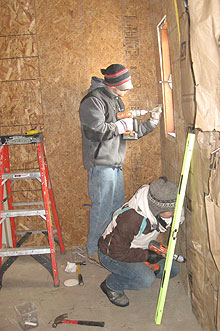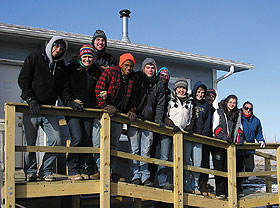  |
| HOME | THIS ISSUE | CALENDAR | PATENTS | BACK ISSUES | < BACK | NEXT > |
Alternative break on reservation expands students' horizonsby Sherry Fisher - March 30, 2009
|
||||
| Daniel Lupacchino has always been drawn to Native American culture. When he heard that there was a chance to spend spring break working on an Indian reservation, he signed up right away.
“I thought it would be a unique opportunity to help people and do some good,” says Lupacchino, a junior studying anthropology. Lupacchino was one of 12 students who spent a week on Pine Ridge Indian Reservation in southwest South Dakota working with the Oglala Lakota People. The trip was sponsored by UConn’s Community Outreach program. Student volunteers helped build and repair houses, installed bunk beds and wheelchair ramps, and helped with clean up projects. They worked with Re-member, a nonprofit organization that seeks to improve the quality of life at Pine Ridge, one of the poorest areas in the nation. “They have a huge overcrowding problem,” says Lauren Young, a sophomore, a double major in psychology and human development and family studies. “Large extended families will often live in a single trailer. That’s why they need three story-high bunk beds.” Young, who was assistant trip director, says the reservation, which encompasses several counties, is equivalent to a third world country. “It’s extremely rural, has the lowest life expectancy in the nation, and health problems like alcoholism.” In preparation for the trip, the student volunteers were required to meet weekly for several months to discuss health care issues in the U.S. and participate in team-building exercises. Young describes her experience on the reservation as “absolutely incredible.”
“Seeing the difference in how we live here and the extreme poverty the people experience is hard to put into words,” she says. “We saw people who lived with 25 others in one small house or a trailer.” Despite their difficult circumstances, the people were very welcoming, she says. “They wanted to share their lives and experiences with us.” Lupacchino describes the experience as life changing. He plans to work there again, and would recommend the experience to other students: “I know there is poverty all over the world, but as Americans, we neglect our own indigenous groups. They deserve to have something back.” Jessica Muirhead, a senior majoring in psychology, was inspired to work with the Lakota People after taking classes in Native American studies at UConn. “I learned things that were disturbing and saddening,” she says, “and I wanted to help remedy the situation.” She adds, “The people were so inspiring. They had so little and gave so much back. For example, there were two people who were homeless because black mold had infested their house, but they were trying to help others in need. I met a lot of role models.” Muirhead, who plans a future in the field of social services, says the experience gave her a new perspective. An unexpected blizzard and sub-zero temperatures didn’t dampen the students’ spirits or their work ethic. They wore layers of clothing and kept to their tasks. “Everyone put forth amazing effort,” says Young. “We got a lot done.” |
| ADVANCE HOME UCONN HOME |


